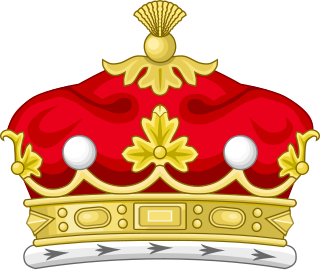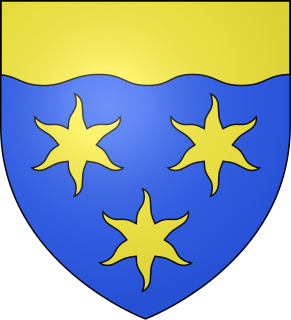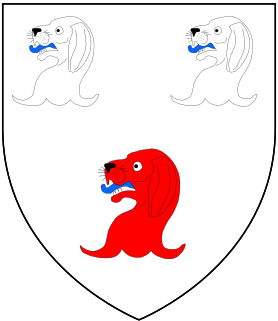Related Research Articles

Earl of Warwick is one of the most prestigious titles in the peerages of the United Kingdom. The title has been created four times in English history, and the name refers to Warwick Castle and the town of Warwick.

Marquess of Bath is a title in the Peerage of Great Britain. It was created in 1789 for Thomas Thynne, Viscount Weymouth. The Marquess holds the subsidiary titles Baron Thynne, of Warminster in the County of Wiltshire, and Viscount Weymouth, both created in 1682 in the Peerage of England. He is also a baronet in the Baronetage of England.

Marquess of Northampton is a title that has been created twice, firstly in the Peerage of England (1547), then secondly in the Peerage of the United Kingdom (1812). The current holder of this title is Spencer Compton, 7th Marquess of Northampton.

Earl of Ilchester is a title in the Peerage of Great Britain. It was created in 1756 for Stephen Fox, 1st Baron Ilchester, who had previously represented Shaftesbury in Parliament. He had already been created Baron Ilchester, of Ilchester in the County of Somerset in 1741, and Baron Ilchester and Stavordale, of Redlynch, in the County of Somerset, in 1747. These titles were also in the Peerage of Great Britain. All three peerages were created with remainder, failing heirs male of his own, to his younger brother Henry Fox, who was himself created Baron Holland in 1763. The brothers were the only sons from the second marriage of the politician Sir Stephen Fox.

Earl of Radnor is a title which has been created twice. It was first created in the Peerage of England in 1679 for John Robartes, 2nd Baron Robartes, a notable political figure of the reign of Charles II. He was made Viscount Bodmin at the same time. Robartes was the son of Richard Robartes, who had been created Baronet in July 1621 and Baron Robartes, of Truro, in the Peerage of England in 1626. All three titles became extinct on the death of the fourth Earl in 1757. Anna Maria Hunt, great-niece of the fourth Earl, married the Hon. Charles Bagenal-Agar, youngest son of James Agar, 1st Viscount Clifden of Gowran. Their son Thomas James Agar-Robartes was created Baron Robartes in 1869. For more information on this title, see the Viscount Clifden.

Viscount Hood, of Whitley in the County of Warwick, is a title in the Peerage of Great Britain. It was created in 1796 for the famous naval commander Admiral Samuel Hood, 1st Baron Hood. He had already been created a Baronet, of Catherington, in the Baronetage of Great Britain on 20 May 1778, and Baron Hood, of Catherington in the County of Southampton, in the Peerage of Ireland in 1782.

Earl of Craven, in the County of York, is a title that has been created twice, once in the Peerage of England and once in the Peerage of the United Kingdom.
Earl of Bradford is a title that has been created twice, once in the Peerage of England and once in the Peerage of the United Kingdom. It was first created in 1694 for Francis Newport, 2nd Baron Newport. However, all the Newport titles became extinct on the death of the fourth Earl in 1762. The Earldom was revived in 1815 for Orlando Bridgeman, 2nd Baron Bradford. The Bridgeman family had previously succeeded to the Newport estates. The title of the peerage refers to the ancient hundred of Bradford in Shropshire, and not, as might be assumed, to the city of Bradford, Yorkshire, or the town of Bradford-on-Avon in Wiltshire.
Baron Ravensworth, of Ravensworth Castle in the County Palatine of Durham and of Eslington Park in the County of Northumberland, is a title in the Peerage of the United Kingdom.

Baron Feversham is a title that has been created twice, once in the Peerage of Great Britain and once in the Peerage of the United Kingdom. The first creation, in the Peerage of Great Britain, came in 1747 when Anthony Duncombe, who had earlier represented Salisbury and Downton in the House of Commons, was made Lord Feversham, Baron of Downton, in the County of Wilts. He had previously inherited half of the enormous fortune of his uncle Sir Charles Duncombe. However, Lord Feversham had no sons and the barony became extinct on his death in 1763. The peerage was revived in the Peerage of the United Kingdom in 1826 in favour of his kinsman Charles Duncombe, who was created Baron Feversham, of Duncombe Park in the County of York. He was a former Member of Parliament for Shaftesbury, Aldborough, Heytesbury and Newport. Duncombe was the grandson of Thomas Duncombe, son of John Brown by his wife Ursula Duncombe, aunt of the first Baron of the 1747 creation. Ursula had inherited the other half of her brother Sir Charles Duncombe's fortune. Lord Feversham son, the second Baron, sat as a Conservative Member of Parliament for Yorkshire and the North Riding of Yorkshire.

Baron Leigh has been created twice as a hereditary title, once in the Peerage of England and once in the Peerage of the United Kingdom. The first creation came in the Peerage of England 1643 when Sir Thomas Leigh, 2nd Baronet, was created Baron Leigh, of Stoneleigh in the County of Warwick. The Leigh Baronetcy, of Stoneleigh in the County of Warwick, had been created in 1611 for his grandfather and namesake Thomas Leigh. The latter was the second son of Sir Thomas Leigh, Lord Mayor of London in 1558, whose third son Sir William Leigh was the grandfather of Francis Leigh, 1st Earl of Chichester. The titles became extinct on the death of the fifth Baron Leigh in 1786.

Baron Poltimore, of Poltimore in the County of Devon, is a title in the Peerage of the United Kingdom. It was created in 1831 for Sir George Bampfylde, 6th Baronet. His son, the second Baron, held office as Treasurer of the Household from 1872 to 1874 in the first Liberal administration of William Ewart Gladstone.

Umberslade Hall is a 17th-century mansion converted into residential apartments situated near Tanworth in Arden, Warwickshire. It is a Grade II* listed building.

Sir Herbert Croft, 1st Baronet was a British politician.
Thomas Archer was an English politician who sat in the House of Commons in 1659 and 1660. He fought in the Parliamentary army in the English Civil War.
Andrew Archer, of Umberslade Hall, Tanworth in Arden, Warwickshire was a British landowner and Tory politician who sat in the House of Commons in three periods between 1690 and 1722.
Sir Simon Archer was an English antiquary and politician who sat in the House of Commons in 1640.

Thomas Archer, 1st Baron Archer was an English Member of Parliament, who was created Baron Archer in 1747. His arms are blazoned: Azure three arrows or.

Andrew Archer, 2nd Baron Archer, 18th-century British Whig politician, styled the Hon. Andrew Archer between 1747 and 1768.

Robert Walpole, 1st Earl of Catherlough, KB, (1702–1772), was a British Member of Parliament for Great Grimsby, Castle Rising, Norfolk (1747–54) and Milborne Port, Somerset (1770–72). He became successively Baron Luxborough (1745), Viscount Barrells and Earl of Catherlough, all titles within the peerage of Ireland. His wife, Henrietta Lady Luxborough, later became well known as a lady of letters, poet and pioneering landscape gardener.
References
- ↑ "No. 8655". The London Gazette . 7 July 1747. p. 2.
- ↑ Memorials of Families of the Surname Archer, John Henry Lawrence-Archer, first published in London, 1861.